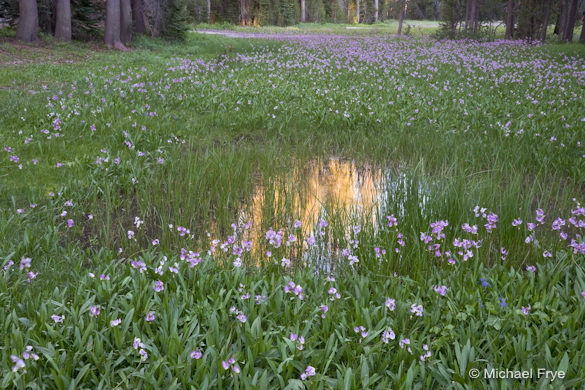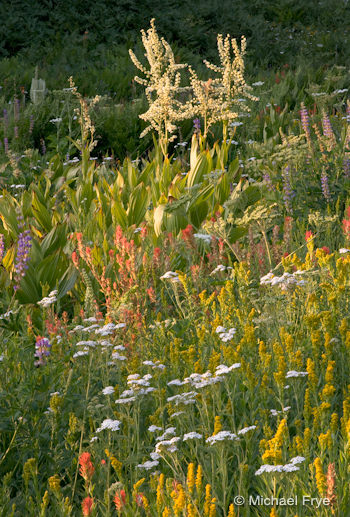
Pond and shooting stars along the Glacier Point Road
It’s late July, and spring is long gone from the Sierra foothills, where I live, and in most of California—indeed, most of the United States. But in the high elevations of the Sierra Nevada the wildflowers are just getting started. Shooting stars are abundant right now between 7000 and 9000 feet in Yosemite. I made the photograph above near the Glacier Point Road last Sunday. But shooting stars are early bloomers, and the rest of the high-country flowers are only beginning to emerge. The peak bloom at these elevations will probably arrive in early August.
Wildlfowers in August? Absolutely. Flowers bloom late in the mountains—in fact one of the best wildflower displays I’ve seen in Yosemite occurred in September after an exceptionally heavy winter.
The best places to look for flowers are often small meadows at around 7000 to 8000 feet. Many areas along the Glacier Point Road fit this description, including Summit Meadow, right next to the road, and McGurk Meadow, which requires a short hike. Naturally these areas are described in my book, the Photographer’s Guide to Yosemite—Location 21 (click here to purchase a signed copy directly from me).
At the beginning of the Tioga Pass Road, Crane Flat Meadows (Location 24) often produce wonderful flower displays. Further up this road you can try looking in some small meadows near White Wolf, and then check out the roadside penstemons between Yosemite Creek and Olmsted Point (Location 27). These penstemons bloom a little earlier—they’re at peak now, or maybe even just past it.
The Tuolumne Meadows area (Locations 29 and 30) seems like an obvious place for wildflowers, and it used to have spectacular displays, but I haven’t seen a good carpet of wildflowers there in 20 years. In the 1980s you could find large swaths of shooting stars and Lemmon’s paintbrush every year, and in exceptional years see those species mixed with other flowers. For some reason those flowers have diminished. However, it’s possible to find small patches of flowers, and many individual blooms suitable for close-ups.
Over on the eastern side of the mountains, Lundy Canyon (Location 36) is well known for its wildflowers. You have to hike beyond the road’s end about a mile or so, just past the waterfall and near a small beaver pond, to reach the best displays. You won’t find thick carpets of flowers there, but can photograph many beautiful individual specimens of columbine, paintbrush, Sierra lily, fireweed, and larkspur.
Tthe right light is vital for photographing flowers. Soft light (shade or overcast) and backlight usually produce the best results. There are always exceptions, of course, but rarely have I had much success photographing flowers with frontlight or sidelight.
Are you still yearning for the days of spring, when flowers were blooming all over California? It’s not too late. There’s another month of wildflower photography left in the Yosemite high country.










I paint flowers and would like to lead a workshop with you whereby participants learn to photograph wild flowers from you and also I teach them to sketch flowers and paint them
Please let me know if that is possible to discuss this idea.
I am a huge fan of your photography
Barbara